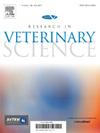Incidence of puerperal metritis and associated risk factors in dairy cows in Hawassa, Southern Ethiopia
IF 2.2
3区 农林科学
Q1 VETERINARY SCIENCES
引用次数: 0
Abstract
Metritis has considerable economic impact on dairy herd profitability due largely to reduced reproductive performance. Studies in Ethiopia only report prevalence, with no available data on the incidence of metritis. The present prospective cohort study aimed to estimate the incidence of puerperal metritis, identify risk factors, and isolate the causative bacteria in dairy cows in Hawassa. Daily follow-up of 120 dairy cows from parturition to 21 days postpartum was carried out from November 2019 to February 2021. Of these, 21 developed puerperal metritis with an incidence rate of 0.94 cases per 100 cow days at risk (95 % CI: 0.6–1.4). The cumulative incidence was found to be 17.5 % (95 % CI: 11.8–25.6). Over 90 % of the puerperal metritis occurred within the first 10 days of parturition. The mean day of occurrence of puerperal metritis was 7.7 days postpartum and the mean rectal temperature in metritic cows was 40.5 °C. Retained fetal membranes (RFM) (p < 0.001) emerged as the only predisposing factor for metritis in the final Cox regression model. Cows with RFM faced a 14.9 times higher risk of metritis compared to cows without RFM. A total of 52 bacterial isolates, belonging to 4 genera, were recovered from the aerobic culture of 21 uterine swab samples. E. coli and Staphylococcus spp. were the most frequently isolated bacteria, with recovery from 21 (100 %) and 20 (95.2 %) of the metritic uteri, respectively. Results of this study suggested the importance of reducing incidence of RFM to reduce incidence of metritis in dairy cows.
埃塞俄比亚南部哈瓦萨地区奶牛产褥期甲沟炎发病率及相关风险因素。
代谢性炎对奶牛群的盈利能力有相当大的经济影响,主要原因是繁殖性能下降。埃塞俄比亚的研究只报告了发病率,没有关于产褥期间质炎发病率的数据。本前瞻性队列研究旨在估计哈瓦萨地区奶牛产褥期元气大伤的发病率、确定风险因素并分离致病细菌。从 2019 年 11 月到 2021 年 2 月,对 120 头奶牛进行了从分娩到产后 21 天的每日随访。其中 21 头奶牛患上产褥期甲沟炎,发病率为每 100 个奶牛危险日 0.94 例(95 % CI:0.6-1.4)。累计发病率为 17.5 %(95 % CI:11.8-25.6)。超过 90% 的产褥期甲沟炎发生在产后 10 天内。产褥炎的平均发生天数为产后 7.7 天,产褥炎奶牛的平均直肠温度为 40.5 °C。胎膜残留(RFM)(p
本文章由计算机程序翻译,如有差异,请以英文原文为准。
求助全文
约1分钟内获得全文
求助全文
来源期刊

Research in veterinary science
农林科学-兽医学
CiteScore
4.40
自引率
4.20%
发文量
312
审稿时长
75 days
期刊介绍:
Research in Veterinary Science is an International multi-disciplinary journal publishing original articles, reviews and short communications of a high scientific and ethical standard in all aspects of veterinary and biomedical research.
The primary aim of the journal is to inform veterinary and biomedical scientists of significant advances in veterinary and related research through prompt publication and dissemination. Secondly, the journal aims to provide a general multi-disciplinary forum for discussion and debate of news and issues concerning veterinary science. Thirdly, to promote the dissemination of knowledge to a broader range of professions, globally.
High quality papers on all species of animals are considered, particularly those considered to be of high scientific importance and originality, and with interdisciplinary interest. The journal encourages papers providing results that have clear implications for understanding disease pathogenesis and for the development of control measures or treatments, as well as those dealing with a comparative biomedical approach, which represents a substantial improvement to animal and human health.
Studies without a robust scientific hypothesis or that are preliminary, or of weak originality, as well as negative results, are not appropriate for the journal. Furthermore, observational approaches, case studies or field reports lacking an advancement in general knowledge do not fall within the scope of the journal.
 求助内容:
求助内容: 应助结果提醒方式:
应助结果提醒方式:


